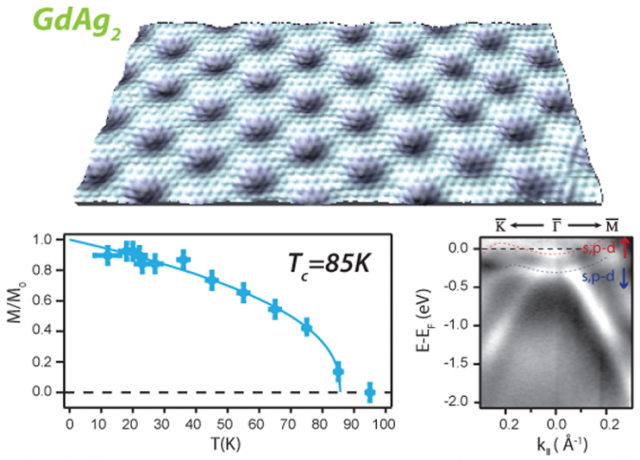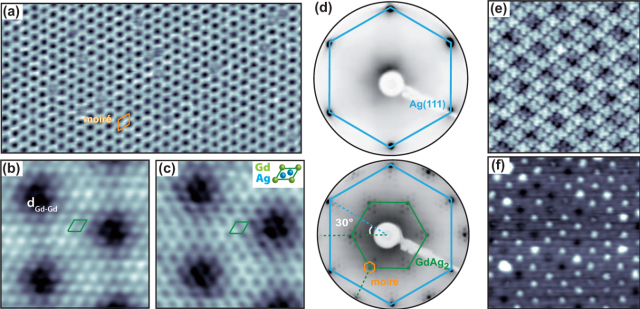An ideal candidate to investigate nanoscale ferromagnets and exotic interfaces
In order to study new solid state magnetic properties appropiate new laboratory models are needed. In particular, there is a necessity for a substrate to investigate new forms of magnetic coupling with nanoscale ferromagnets and the exotic physics at the interface with semiconductor or superconductor materials. Now a team of researchers from DIPC and some other institutions may have found one.

Fundamental research on magnetism as well as many potential nanotechnology applications on spintronics rely, to a great extent, on the ability to interface magnetic materials with superconductors, topological insulators, and organic or inorganic semiconductors. To achieve this, tailoring magnetic properties on structurally robust substrates is crucial.
The survival of the long-range magnetic order upon interface formation is a basic requirement, and that is the reason why, besides structural stability and chemical inertness, substrate materials with strong ferromagnetism, i.e., high Curie temperatures (that above which they become paramagnetic), are sought. Although high Curie temperatures are readily found at the surface of some elementary ferromagnetic materials, interfacing them very often results in intermixing and finally in the lack of structural and magnetic control.
Rare-earth/noble metal monolayer alloys, grown on noble metal surfaces like gold or silver, represent an interesting alternative as magnetic templates. This is because, besides their structural stability, their nanoscale modulation offer a way to drive the growth of nanosized heterostructures.
Different elements of the lanthanide series have been recently observed to form surface-confined alloys on gold surfaces Au(111), characterized by a high crystal quality and nanoscale periodic corrugation. In the case of the gadolinium-gold (Gd-Au) combination- we already discussed the origin of ferromagnetism of Gd here – by varying the Gd coverage, moiré or trigon patterns can be tuned, which have been shown to drive the self-organized growth of cobalt (Co) nanodot arrays.
Notably, the Gd−Au templates remain structurally stable upon Co growth, allowing to trigger antiferromagnetic coupling of the Co nanodot array with the supporting Gd alloy. Given the variety of rare earth elements and their exotic magnetism, the observations made on a particular Gd-Au alloy, GdAu2,encouraged a thorough search combining different rare earth elements and noble metals.

What the team led by F. Schiller, from Materials Physics Center CSIC-UPV/EHU, and J.E. Ortega, from DIPC, has now done1 is a comprehensive experimental and theoretical investigation of the electronic structure of a gadolinium-silver alloy, GdAg2, in parallel with the structurally identical GdAu2, and found important and interesting differences.
Actually, the researchers study the monolayer-thick GdAg2, which has the three optimal substrate properties, namely, structural stability, nanoscale modulation, and ferromagnetism. The experimental and theoretical investigation combines scanning tunnelling microscopy (STM), X-ray magnetic circular dichroism (XMCD), and magneto-optic Kerr effect (MOKE) experiments.
The fisrt interesting result is that GdAg2 grown on Ag(111) exhibits an excellent crystal quality and ferromagnetic order. But more intriguing is the surprisingly high Curie temperature 85 K, particularly compared to that of GdAu2 of only 13 K.
This different ferromagnetic behaviour in GdAu2 and GdAg2 monolayer alloys cannot be straightforwardly predicted using previous knowledge of the respective bulk compounds since these are lower temperature antiferromagnets. To understand the underlying physics, the researchers combine angle-resolved photoemission (ARPES) experiments and density functional theory (DFT) calculations to conclude that it depends on how the two noble metal fill the hybrid bands that they form with gadolinium.
In summary, the GdAg2/Ag(111) substrate appears as an ideal candidate to investigate those new forms of magnetic behaviour of nanoscale ferromagnets and exotic interfaces.
Author: César Tomé López is a science writer and the editor of Mapping Ignorance
References
- M. Ormaza, L. Fernández, M. Ilyn,A. Magaña, B. Xu, M. J. Verstraete, M. Gastaldo,M. A. Valbuena, P. Gargiani, A. Mugarza,A. Ayuela, L. Vitali, M. Blanco-Rey, F. Schiller, and J. E. Ortega (2016) High Temperature Ferromagnetism in a GdAg2 Monolayer NanoLetters doi: 10.1021/acs.nanolett.6b01197 ↩